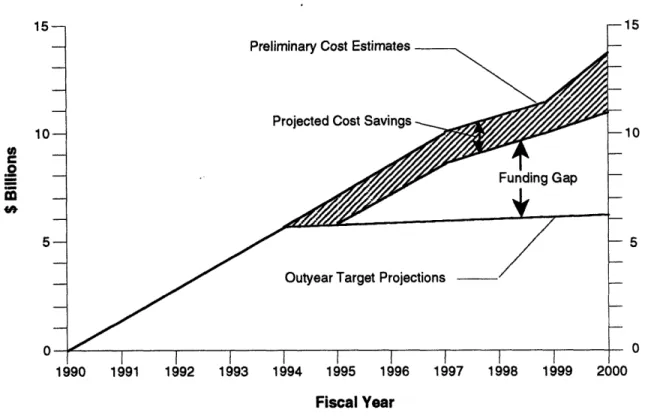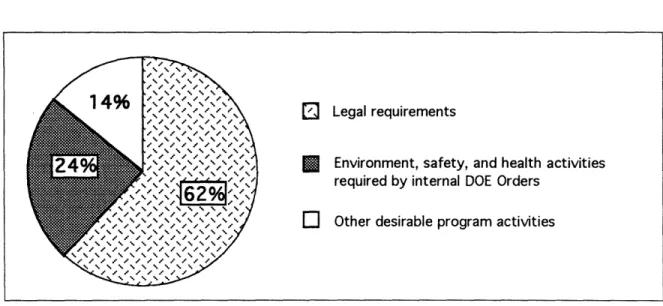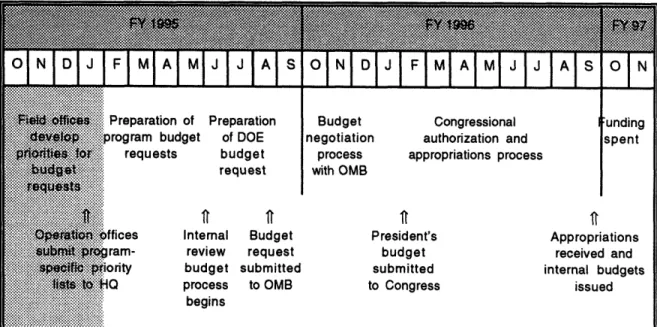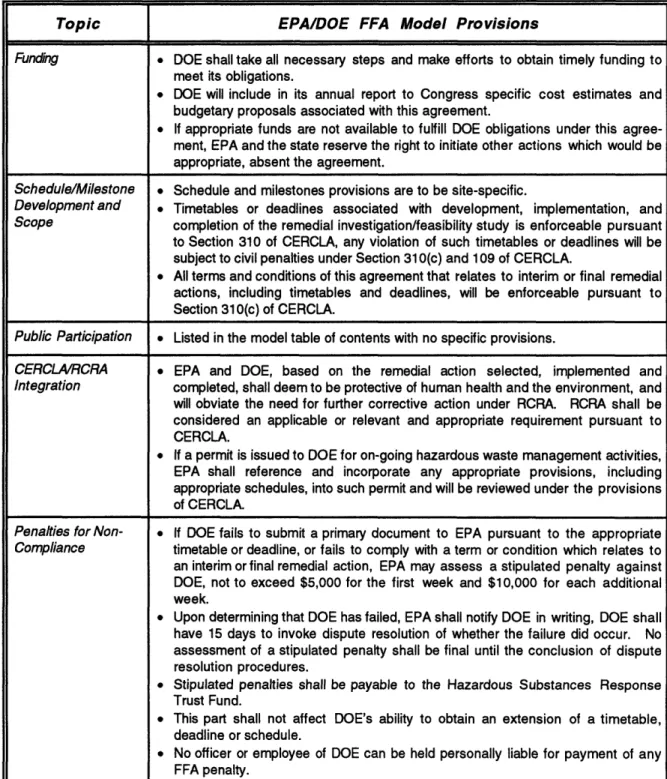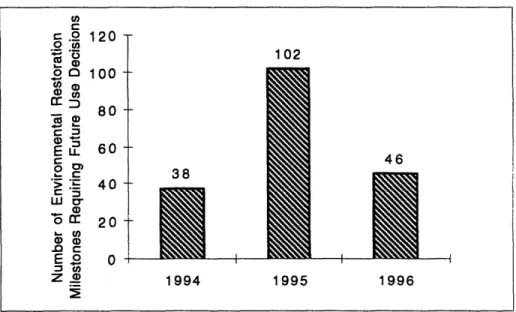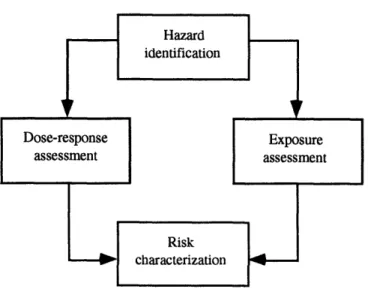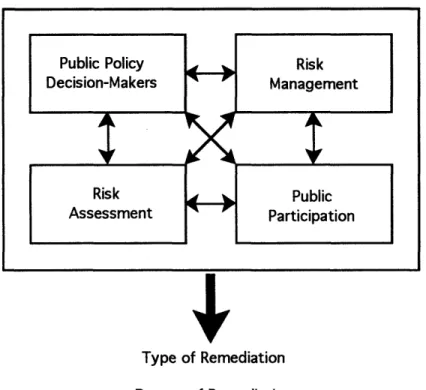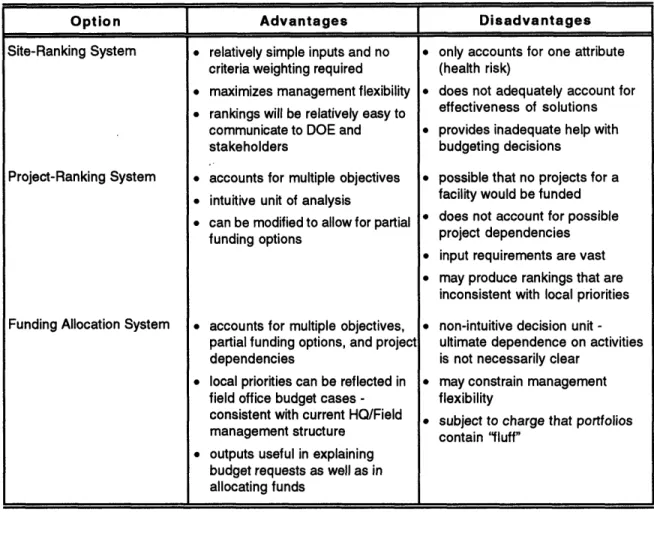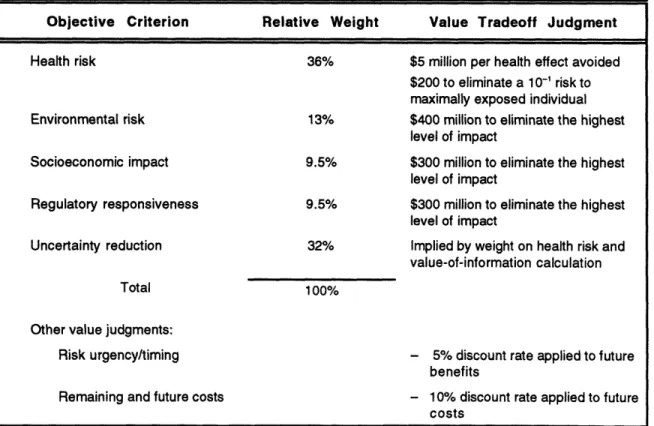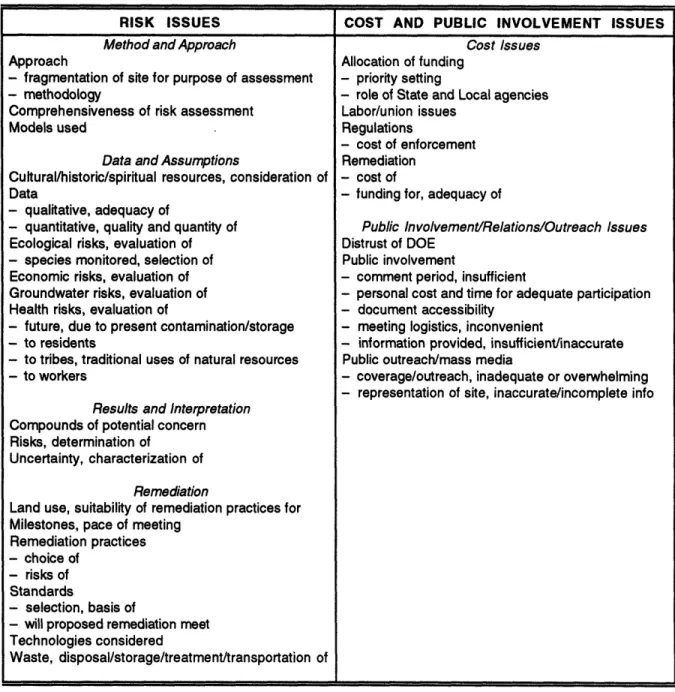Barriers to Implementing Risk-Based Decision Making for the
Department of Energy's Weapons Complex Cleanup Program
by
Alice K. Caponiti
B.S., Civil Engineering
University of Maryland at College Park, 1991 Submitted to the Department of Nuclear Engineering in partial fulfillment of the requirements for the degrees of
Master of Science in Nuclear Engineering and
Master of Science in Technology and Policy
MASSACHUSETTS INSTITUTE OF TECHNOLOGY June 1995
© 1995 Alice K. Caponiti. All rights reserved.
The author hereby grants to MIT permission to reproduce and distribute publicly paper and electronic copies of this thesis document in whole or in part.
I,/ I
Author ... ... Department of Nuclear Engineering
Certifiedbl'yi-;;;;;-... ... . _... ...
Kent H . .serrofe'sso6r-6Nuclear Engineering Thesis Advisor
Certified by ... ...
John RS/ enfeld, S-rec te
7
(/V Thesis
Reader
Accepted by ... ...- -...
V Richard'deN ufville
Chairman, Technologyv and Plicy Program
Accepted by ...
l1an Henry
Chairman, Departmental Committee on Gradruate Studies
Barriers to Implementing Risk-Based Decision Making for the
Department of Energy's Weapons Complex Cleanup Program
by
Alice Caponiti
Submitted to the Department of Nuclear Engineering on May 24, 1995 in partial fulfillment of the requirements for the degrees of Master of Science in Nuclear Engineering
and Master of Science in Technology and Policy
ABSTRACT
The Office of Environmental Management (EM) is responsible for cleaning up the contamination and waste across the Department of Energy's (DOE) nuclear weapons complex. The costs associated with effort are enormous; the current annual budget for EM hovers around six billion dollars and is expected to increase in the coming years as the program advances from characterization to remediation. Congress has warned that there will not be an endless source of funding and that risk-based priorities should be established for cleanup.
DOE has not adopted a formal prioritization strategy. Remediation decisions, and the costs associated with those decisions, are currently driven by compliance agreements negotiated between DOE, the states, and the Environmental Protection Agency (EPA). Risk-based prioritization (placing priority on activities that will reduce the most risk to human health and the environment) has been gaining attention as a rational method for allocating funds with limited resources. This thesis assesses the managerial, institutional and political barriers to adopting a risk-based approach for setting remediation priorities; and recommends an alternative strategy for framing the program's objectives
and measures for progress.
My analysis concludes that many of the key barriers to adopting a risk-based approach, which include the divergent perceptions of risk between the public and risk practitioners, parochial interests served by avoiding such an approach, and institutional deficiencies
in the collection of risk information, are beyond DOE's influence to overcome, especially if the Department remains committed to an open and participatory decision-making process. As part of my recommendations, I suggest that DOE adopt a strategy for measuring cleanup performance, not by risk reduction, but by the successful remediation
ACKNOWLEDGMENTS
First, I would like to express my appreciation for the support and love so generously given by my Mom, Dad and brother, Tony. Though we be scattered across the globe, I still derive strength and confidence from the solid footing of my family's love.
I wish to thank my advisors, Kent Hansen and John Ehrenfeld, for their patience and support and for guiding me though the process that transforms an "interesting" topic into a master's thesis. My'tenure at MIT was made possible through financial support granted by the Department of Energy. I would especially like to thank my supervisor Mac Lankford and mentor Bill Scott, without whom I would have stumbled astray in bureaucracy. Much guidance and insight were provided by Randy Harris and Frank
Baxter, formerly of the Office of Integrated Risk Management, DOE.
My special thanks goes to my friends in the Technology and Policy Program, including
my soulmate and partner-in-crime, Nick Gertler; Shanthi for her congeniality and probing questions; Mark for feeding me; Andrew and Edmond for their inspiring transformation into hockey gods; Mort for introducing us to inner beauty (or is it spiritual interiors?); and to everyone who made TPP a rewarding experience.
TABLE OF CONTENTS
Abstract
...
3
Acknowledgments ...4 Table of Contents ... 5 List of Figures ... 6 List of Tables ...7 List of Boxes ... 7List of Abbreviations and Acronyms ...8
Chapter 1 Introduction ... 9
1.1 Environmental Management Cleanup Program ... 9
1.2 Need for Prioritization ... 14
1.3 Public Role in Remediation Choices ... 15
1.4 Organization of Thesis ... 17
Chapter 2 EM Framework for Decision-Making ... 19
2.1 Current Framework ... 19
2.2 Compliance Agreements ... 24
2.2.1 Commitments to long-term milestones ... 25
2.2.2 Inadequate Consideration of Future Land Use Planning ...27
2.2.3 Not Responsive to Changes in Scope ... 29
CHAPTER 3 Methodologies for Risk-Based Prioritization ... 31
3.1 Uncertainties and Controversy in Assessing Risk ... 31
3.2 Use of Risk in Setting Priorities ... 35
3.2.1 Risk-Ranking Models ... 35
3.2.2 Comparative Risk Analysis ... 36
3.2.3 Multiattribute Utility Analysis ... 38
3.3 Environmental Restoration Priority System ... 38
3.4 FFER Committee Recommendations for Funding Allocation ... 43
3.5 Congressional Push for Risk-benefit Analysis ... 45
CHAPTER 4 Barriers ... 47
4.1 Risk Perception and the Public Role ... 4...48
4.2 Public Distrust of DOE ... 55
4.4 Funding Allocation and Legal Agreements ... ... 59
CHAPTER 5 Conclusions and Recommendations ... 62
5.1 A Clear, National Strategy is Needed ... 63
5.1.1 Current Strategies are Insufficient ... 64
5.1.2 Serious Barriers to a Risk-based Approach ...66
5.2 Define a New Measure for Progress ... 67
References... LIST OF FIGURES Figure 1-1. Illustration of impending funding shortfalls for the EM program ... 13
Figure 2-1. Estimates for FY 1994 budget allocation for the Office of EM ... 19
Figure 2-2. DOE budget process for FY 1997 ... 21
Figure 2-3. Number of environmental remediation milestones requiring future use decisions .... 29
Figure 3-1. Four steps of a quantitative risk assessment. ... 32
Figure 3-2. Four major factors that influence remedial action decisions ... 34
Figure 4-1. Two-factor space for identifying a spectrum of risk characteristics ... 52
Figure 4-2. Plot of various hazards whithin the two-factor space ... 52
LIST OF TABLES
Table 2-1. Major provisions of the DOE/EPA model for an FFA compliance agreement... 26
Table 3-1. Comparison of three alternative priority systems ... 40
Table 3-2. Weights assigned to the five objectives in ERPS ... 41
Table 4-1. Ssummary of risk concerns...49
Table 4-2. Minimum acceptable distance to various hazardous facilities ... 50
Table 4-3. National survey assessing trust in DOE . ... 56
LIST OF BOXES Box 1. Four major tasks of the Environmental Management program ...11
Box 2. Enforceable agreements and regulatory drivers ...20
LIST OF ABBREVIATIONS AND ACRONYMS
CERCLA Comprehensive Environmental Response, Compensation, and Liability Act CRA Comparative risk analysis
D&D Decontamination and decommissioning DOD U.S. Department of Defense
DOE U.S. Department of Energy
EM Office of Environmental Management
EPA U.S. Environmental Protection Agency ER Office of Environmental Restoration ERPS Environmental Restoration Priority System
FFA Federal Facility Agreement FFCA Federal Facility Compliance Act FY Fiscal year
HRS Hazard Ranking System
HQ DOE headquarters
IAG Interagency Agreement
MUA Multi-attribute utility analysis NAS National Academy of Sciences NEPA National Environmental Policy Act NRC National Research Council
OMB Office of Management and Budget
ppm Parts per million
RCRA Resource Conservation and Recovery Act
SAR Safety Analysis Report
SSAB Site-specific advisory boards
1 Introduction
1.1 Environmental Management Cleanup Program
Since the Manhattan Project, established during World War II, the Department of Energy (DOE) and its predecessor agencies' have been engaged in the monumental task of the research, development and testing of nuclear weapons. The enormous infrastructure of chemical processing and metal manufacturing plants, laboratories, nuclear reactors, and testing grounds established to support this mission has come to be known as the "weapons complex." At the peak of production during the Cold War, this complex consisted of 16 major facilities, including vast reservations of land in the states of Nevada, Idaho, Washington, and South Carolina, and now encompasses 2.3 million acres of land and 120 million square feet of buildings (DOE, 1995a). And though it was recognized early that weapons production would bring about a legacy of serious environmental contamination and waste management problems,2 the imperatives of the nuclear arms race demanded that production, and not the environment, be given first priority.
In 1989 the Office of Environmental Management (EM) was established to consolidate
the waste management and environmental remediation activities of various DOE programs under one organizational structure. The creation of the EM program occurred at a time during which nuclear weapons production was falling off dramatically for several well-known reasons. Key facilities in the production process were temporarily shut down for safety and maintenance decisions, and the resumption of operations at those facilities became increasingly less certain with decisions to significantly scale back the nuclear arsenal. EM became the landlord for those facilities no longer needed for weapons production.
The technical, planning, and institutional challenges facing the Office of Environmental Management are daunting. Many of the weapons complex facilities were constructed
The Atomic Energy Commission (1946 - 1975) and the Energy Research and Development Administration (1975 - 1977).
2 Shortly after the establishment of the Atomic Energy Commission in 1946, its Safety and
Industrial Health Advisory Board reported that the "disposal of contaminated waste in present quantities and by present methods...if continued for decades, presents the gravest of
prior to the development of major environmental controls, and are now found to be out of compliance with applicable environmental regulations. The complex has approximately 4,000 contaminated sites which include unique radiation hazards, unprecedented volumes of contaminated water and soil, and a vast number of contaminated structures awaiting decontamination, decommissioning and
dismantlement (DOE, 1993; DOE, 1995a).
The primary mission of the EM program, as envisioned by the current administration, is to protect human health and the environment. In order to accomplish this mission, the present Assistant Secretary for Environmental Management has established the
following six major goals (DOE, 1994a):
1. Manage and eliminate urgent risks and threats.
2. Provide a safe workplace that is free from fatalities and serious accidents, and continuously reduces injuries and adverse health effects.
3. Change the system so that it is under control managerially and financially. 4. Demonstrate tangible, outcome-oriented results.
5. Focus the technology development program on DOE's major Environmental Management issues.
6. Develop stronger partnerships between DOE and its stakeholders.3
In part, these goals were established to address a perceived need to stop doing "business as usual." Critics from both within and outside of the agency felt that the EM program has in the past been operating with inadequate risk information, inefficient and ineffective remediation technologies, poor project definition and management, and rigid
compliance agreements imposed as a result of a lack of credibility (DOE, 1994a).
The Environmental Management mission is comprised of four major activities: nuclear materials and facility stabilization, environmental restoration, waste management, and
technology development (see Box 1). While the tendency is to label the EM program as
simply "cleanup", in reality it encompasses the management of complex facilities and requisite support responsibilities, including health and safety compliance measures, facility maintenance, and plant system upgrades.
3 The term "stakeholders" refers to the general public, Indian tribes, regulators, citizen's organizations, and state and local governments. The increasing use of this term reflects DOE's focus on being open and responsive to those who are impacted by and otherwise concerned about agency decisions.
Box 1. Four Major Tasks of the Environmental Management Program.
Nuclear Materials and Facilities Stabilization - Consisting of the most urgent and high-risk
activities, this task involves stabilizing and maintaining a large number of nuclear materials and facilities which are no longer necessary for the production of nuclear weapons. Stabilization of the sensitive nuclear materials is necessary to prevent leaks, explosions, theft, terrorist attack, or avoidable radiation exposures. Because many of the facilities are more than 40 years old and have begun to deteriorate, they must be stabilized to protect the safety of cleanup workers prior to undertaking activities for decontamination and decommissioning.
Environmental Restoration - Tasks necessary for remedial action encompass discovery of
site contamination, site characterization, analysis of cleanup alternatives, and selection of a remedy. Examples of remediation activities are stabilizing contaminated soil; pumping and treating groundwater; decontaminating, decommissioning, and demolishing process buildings, nuclear reactors, and chemical separation plants; and exhuming sludge and buried drums of waste. In many cases no safe or effective technology is available to address the contamination problem. Environmental restoration activities are accomplished through negotiated cleanup agreements into which DOE has entered with the EPA and host states. These agreements are tailored to the specific conditions at each site, including the properties and magnitude of contamination in the environmental media.
Waste Management - This task involves the minimizing, treating, storing, and disposing
of wastes generated by ongoing activities at active facilities, as well as those wastes generated by the decontamination and decommissioning of surplus facilities. Among the numerous factors that increase the complexity of this task are the requirement to treat the hazardous component of mixed hazardous and radioactive waste; the uncertainty in both the nature and volume of waste generated by restoration activities; the impact of new regulatory requirements; and the need to define treatment requirements and develop acceptable treatment facilities.
Technology Development - This task seeks to develop, test, and demonstrate affordable
and effective solutions to the numerous technical problems facing the Environmental Management program. In developing innovative technologies, ideas are sought from sources in the private sector, universities and other government agencies, in addition to relying on traditional sources of expertise at the DOE national laboratories.
(DOE, 1995a; DOE, 1992a)
The costs associated with this effort are enormous; the current annual budget for EM hovers around six billion dollars and is expected to increase in the coming years. Initial estimates predicted that the annual EM budget would increase to well over $10 billion by the year 2000, as the program proceeds from a characterization and assessment phase toward the more costly work of remediating contaminated sites and treating waste. Estimates of projected growth must account for costs of handling new volumes
of waste generated by remediation activities and the decontamination and decommissioning of surplus facilities.
DOE managers are struggling with the possibility that, given the present course of action, the costs of remediating the weapons complex will soon exceed what Congress is willing to pay. The first signs of trouble appeared with the passage of the Deficit Reduction Act of 1993. This Act established federal spending caps such that budgets for federal programs will be required to remain level or be allowed to increase only at a small rate, rather than at the higher rate initially estimated for the Environmental Management program. Funding constraints became even more imminent with significant budget cuts proposed by President Clinton in January, 1995. As part of the proposed cuts in federal spending, the Department of Energy is facing reductions of $10.6 billion over the next four years, with $4.4 billion targeted for the EM program. These proposed cuts, which will impact the 1997 budget cycle and beyond, are expected to cause a $17 billion funding gap between available dollars and compliance costs over the next five years (Grumbly, 1995a). This issue has raised a great deal of concern among stakeholders who fear that DOE will be unable to meet legally binding and statutorily driven commitments for cleaning up the complex.
DOE is responding to its bleak fiscal outlook by taking measures to reduce costs through increased efficiency and productivity. Such measures, which include reductions in indirect and overhead labor costs, contract reform, privatization, and streamlining, are expected to achieve over $9 billion in savings (Grumbly, 1995a). Yet, these projected savings fall well short of eliminating the impending funding shortfall (see Figure 1-1).
15 10 .2 m 5 0
Preliminary Cost Estimates
10
5
0
Fiscal Year
Figure 1-1. Illustration of impending funding shortfalls for the EM program. Preliminary annual cost estimates reflect the "business as usual" approach. Revised outyear target projections for available funding conform to the more stringent funding levels imposed by reductions in federal spending. In spite of managerial efforts to reduce costs and improve efficiency, significant funding shortfalls appear likely. This figure has been used by the current EM administration in numerous settings, in part to demonstrate the need for renegotiating compliance agreements and other cost saving measures.
1.2 Need for Prioritization
There is a strong possibility that DOE may be requested to develop a strategy which explicitly addresses risk reduction for prioritizing cleanup activities. Consider the following language introduced in the U.S. House of Representative's Conference Report 103-292 (October 14, 1993) for budget appropriations:
The conferees wish to reiterate concerns raised by both the House and Senate with respect to the overall cost of environmental cleanup actions that the Department has committed to perform under existing compliance agreements. While committed to providing adequate funding for necessary cleanup activities around the country, the conferees emphasize that there will not be an endless source of funding for this program with significant increases in the outyears. ...
The conferees agree that the Department needs to develop a mechanism for establishing priorities among competing cleanup requirements. Toward this end, the Department is directed to review compliance agreements and to submit ... a report ... evaluating the risks to the public health and safety posed by the conditions at weapons complex facilities that are addressed by compliance
agreement requirements. (HR, 1993)
Risk-based prioritization (placing priority on activities that will reduce the most risk to human health and the environment) has been gaining attention as an important element of a rational approach for allocating limited remediation funds (CBO, 1994; NRC, 1994a; NRC, 1994d). DOE has not adopted a formal prioritization strategy. The pace of remedial actions, and the costs associated with those actions, are currently driven by compliance agreements negotiated between DOE, the host states, and the local EPA regions. Many of these agreements, which establish milestones (actions and associated timetables) for complying with environmental regulations, were negotiated at a time when the Department's mission was transitioning from production to cleanup and without an adequate understanding of the scope and scale of the problems at hand. Further, the majority of agreements fail to address broader policy issues of future land use planning and economic development of sites,4both of which directly impact desired levels of cleanup and associated risks.
That the Department of Energy needs to address prioritization of its massive cleanup program is a notion with which many observers would agree. Merely having the program
4 Land use planning seeks to identify stakeholder-preferred future use options at each site. Economic development planning enables communities to reuse surplus facilities and technologies
driven by rigid compliance agreements and constraints posed by numerous environmental regulations seems to be sacrificing an opportunity for guiding the program with sound policy and management. Compliance agreements provide a mechanism for establishing local priorities for reducing risk. And while they may be appropriate for intra-site priority-setting, they do not allow for inter-site comparisons of hazards to inform a rational distribution of funds among sites.
1.3 Public Role in Remediation Choices
In part due to DOE's efforts in improving public participation in remediation decisions and a growing demand by the public that tax dollars be used more responsibly by federal decision makers, some local citizens are calling for improved quality of risk information, and rational use of that information, in selecting cleanup options. Through forums such as site-specific advisory boards (SSABs) and other citizen working groups established at most sites to actively involve representatives of the local community in the cleanup decision-making process, members of affected communities are achieving improved access to information regarding site conditions, leading to an increased awareness of environmental and health effects of contamination and a recognition of the complexity and scientific uncertainty surrounding many decisions at sites (FFER, 1993). One result of improved dissemination of information is that DOE managers and EPA regulators are having to work with a public which demands dialogue on serious, and indeed tough, issues that warrant thoughtful debate. Such dialogue can lead to surprising revelations about how stakeholders view risk reduction associated with cleanup decisions.
For example, a recent public meeting to gather comments on DOE's proposed $69 million plan to clean the East Fork Poplar Creek of mercury contamination discharged from the Oak Ridge Y-12 plant drew over 200 attendees. The plan consists of excavating about 54,000 cubic yards of soil containing at least 180 parts per million
(ppm) of mercury and trucking it to a Y-12 disposal site. The majority of comments
offered at this meeting criticized the plan as a waste of taxpayer money and considered the conservative approach for determining the cleanup standard for mercury an example of "excessive conservatism" to protect the public from seemingly minor risks (KNS,
1995; OR, 1995a).
At issue was the applicability of the risk assessments used to determine the cleanup level. Some argued that the actual risk to human health would be far less than estimated because the risk assessments were based on animal studies that tested response to mercury chloride, which is 3 million times more soluble than the mercury sulfide form commonly found in the floodplain (KNS, 1995). One resident proposed raising the
cleanup level for mercury from 180 to 1,200 ppm. The EPA representative reasoned
that "we can't be sure what is safe so we are going way beyond a normal standard of safety," consistent with EPA's policy of erring on the side of caution (OR, 1995a). Other residents argued that the excavation would cause more harm than good for the affected wildlife and would unnecessarily destroy the aesthetic value of the creek. In the words of one resident whose property abuts the creek:
No one eats the dirt. No one fishes in the stream. No one swims in the stream and I have never seen anyone wading or playing in the water. No one eats any of the rats, mice, snakes, turtles, geese, moles, groundhogs, rabbits, squirrels, deer, herons, skunks, sparrows, finches, chickadees, grackles, crows, ravens, hawks, robins, titmice, bluejays, cardinals, grossbeaks, cowbirds, wrens, nuthatches, woodpeckers, etc., etc., that are present.... We are opposed to having the trees cut, the soil removed and the stream disturbed. This would be an unnecessary expenditure of the government's - our - money. (OR, 1995b)
Although this example is perhaps unusual as an instance where a community is calling for less action rather than more, it should serve to inform decision makers that in some instances the desire to cleanup has overtaken the desires of those whom these efforts are intended to protect. Further, while this example does not directly speak to the issue of risk-based prioritization, it does illustrate several important points regarding the quality and use of risk information in cleanup decision-making.
* Members of the affected public are willing to engage in discussion on the technical merits of proposed remediation activities, and not merely the emotional aspects as many critics of public participation would suggest.
* Stakeholders are not simply interested in cleaning up at all costs. The public wants to be assured that environmental remediation funds are being used wisely and that their values are incorporated into cleanup decisions.
* Until there are significant improvements in risk assessment methodologies, there will frequently be a great deal of uncertainty in estimates of risks to human health. The manner by which this uncertainty is accommodated in cleanup standards (i.e., conservatively) may not reflect the wishes of the affected community.
* Reductions in health risks may not adequately balance the increased harm to the environment resulting from remediating to human health standards. Stakeholders desire rational cleanup standards that reflect future land-use plans that they have
1.4 Organization of Thesis
The Environmental Management program faces major policy and management decisions about how to prioritize its environmental restoration activities. Given the current and future budget constraints, the EM cannot attempt to address all risks simultaneously. In spite of widespread support for DOE to adopt a risk-based approach to establish program priorities, including senior-level support from within the Department, DOE has not been able to formulate a workable strategy for doing so. This thesis examines the current framework for decision-making, as well as an unsuccessful prior attempt to set environmental restoration priorities, in order to answer the following questions:
1. What are the major managerial, institutional and political barriers to adopting a risk-based approach for setting remediation priorities?
2. To what extent are these barriers within the Departments ability to overcome? 3. How should the Department proceed to address the need to rationally allocate
limited funds for completing its mission?
Chapter 2 reviews the existing framework for decision making. Environmental restoration priorities are dictated in large part by compliance agreements negotiated on a site-by-site basis to establish enforceable schedules for remedial actions, as well as by other environmental regulatory drivers. In this chapter, I describe the manner by which the prioritization of cleanup activities is constrained to these drivers through the budget process. I also describe how key deficiencies in compliance agreements impede progress toward the development of a more rational basis for allocating limited resources for cleanup.
Chapter 3 begins with an overview of risk assessment and risk management principles. Much of the controversy in using risk information to inform priority setting stems from disagreement or misunderstanding on the roles of science, judgment, and public concerns in risk analysis. I describe three risk-based tools which have been gaining acceptance for developing risk-based priorities: risk-ranking models, comparative risk analysis, and multiattribute utility analysis. Each has strengths and weaknesses that render them appropriate to support different types of decisions. I then recount a prior attempt by EM to use one of these tools to establish program priorities and identify the major criticisms that led to the abandonment of this tool. The chapter concludes with examples of conflicting influences that continue to frustrate DOE's efforts to manage the EM program in a publicly acceptable manner; on one side, a committee representing states, regulators and other stakeholders is explicitly opposing priority setting based on
inter-site comparisons of risk, while on the other side, Congress is urging the Department to adopt a cost-benefit approach as a means to prioritize its limited resources to address the most serious and cost-effective risks first.
Chapter 4 presents an analysis of the key barriers to risk-based decision making that EM is struggling to address in its pursuit of a rational approach for allocating limited resources. I begin with an assessment of the factors that influence public perception of the unique hazards posed by the weapons complex. Because DOE has committed to improving stakeholder participation in shaping the decisions that affect them, it is important that the management recognize the factors that influence risk perception and understand the limitations in bridging divergent views on risk. Next, I identify some of the deficiencies in the type and quality of risk data that limit its usefulness in informing broader risk-based decisions. And finally, I examine the political barriers that work to keep DOE bound to the present system of having legally enforceable, site-specific agreements drive the pace of remediation.
In Chapter 5, I explain why the barriers to a national risk-based approach for priority setting are beyond DOE's influence to overcome, especially if the Department remains committed to an open and participatory decision-making process. Given the short time frame in which the Department is expected to demonstrate progress in its environmental program, I contend that DOE should shift its efforts from a risk-based approach to a more tractable framework. As part of my recommendations, I suggest that DOE adopt
a strategy for measuring cleanup performance, not by risk reduction, but by the successful remediation of land to a level appropriate for a designated future land use. Priorities for environmental restoration should be established consistent with such a performance-based goal.
2 EM Framework for Decision-Making
2.1 Current Framework
A formal framework for explicitly prioritizing cleanup activities across the complex does not exist. Any prioritization that occurs is part of the overall budget formulation process for EM. As such, the decisions to support activities for waste management or environmental remediation are driven primarily by the need to comply with formal agreements negotiated between DOE, the local EPA region, and responsible state agencies, as well as by other environmental regulatory drivers (see Figure 2-1). Box 2 (see below) provides descriptions of the major environmental drivers which impact budget allocation. The following description of the budget formulation process illustrates the manner by which the prioritization of cleanup activities is constrained to these drivers.
0 Legal requirements
IM Environment, safety, and health activities
required by internal DOE Orders
I- Other desirable program activities
Figure 2-1. Estimates for FY 1994 budget allocation for the Office of Environmental Management. The majority of funded activities are legally driven. (DOE, 1993)
Box 2. Enforceable Agreements and Regulatory Drivers
Federal statutes and regulations - DOE activities are governed by a number of laws and
regulations that are enforced by other Federal agencies and State and local regulators.
- National Environmental Policy Act (NEPA), which requires that environmental impact statements be prepared for actions that may significantly affect the quality of the human environment.
- Resource Conservation and Recovery Act (RCRA), which provides the frame-work for managing solid and hazardous wastes produced from ongoing activities.
- Comprehensive Environmental Response, Compensation, and Liability Act (CERCLA, also known as Superfund), which sets the ground rules for cleaning up releases of hazardous substances at closed or abandoned sites.
- Federal Facility Compliance Act (FFCA), which was enacted in 1992 specifically to address problems related to the treatment of hazardous waste generated or stored at Federal facilities by directing such facilities to comply with RCRA requirements.
Other applicable regulations include the Clean Water Act, Clean Air Act, Occupational Safety and Health Act,5Atomic Energy Act, Safe Drinking Water Act, and the Toxic Substances Control Act.
Compliance agreements - DOE has entered into facility-specific agreements with EPA and
state regulatory agencies which address the actions necessary to achieve compliance with CERCLA requirements and may also address RCRA corrective actions. These agreements are legally binding and establish specific milestones for completion of program activities.
Court orders/consent decrees - These are court-ordered actions to bring facilities into
compliance with RCRA requirements. Failure to meet such actions can result in immediate fines.
State or local statutes or regulations - Most states have enacted legislation similar to
Federal environmental statutes. In many instances state and local regulating agencies are permitted to require more stringent standards than those provided for in Federal statutes.
Agreements in principle - These are non-contractual (handshake) agreements between
DOE and states to provide funding or other support for certain actions desired by the state (e.g., provide funding to establish a governor's task force to track remediation progress at a site). Agreements in principle have been established with 13 states to date.
(DOE, 1993; Harris, 1995a)
5 Although DOE retains oversight over its worker health and safety programs, it has committed itself to meeting the Occupational Safety and Health Administration guidelines.
The DOE budgeting and appropriation process for securing funding for its hazardous waste remediation projects involves development of a cleanup program budget by EM; integration of the EM budget into the overall DOE budget; submittal of the DOE budget to the Office of Management and Budget (OMB, the Presidential office for the budget); and review and approval (or disapproval) by Congress (DOE, 1991a). The budget planning for each fiscal year in the three-year Federal budget process begins two years before the year in which the budget is actually executed. Figure 2-2 identifies the major phases of the FY 1997 budget planning process.
The instructions to DOE headquarters and field personnel for putting together a budget request are delivered through budget formulation guidance and are revised regularly to focus on the Environmental Management program's highest priorities. Responding to the constrained fiscal environment that the Department faces today, the EM budget guidance for fiscal year (FY) 1997 addresses the need to achieve compliance in a cost effective manner while still supporting the six major program goals previously mentioned. As directed in the FY97 budget formulation guidance, EM must base its budget requests upon the principle of risk reduction and the explicit requirements of enforceable agreements and Federal laws (DOE, 1994b). Additionally, the current guidance stresses the need to reduce costs of doing business, to improve productivity
ON D FMA M J D JA F 0N M A M J J A S O N
Fie' i~ff~ Preparation of Preparation Budget Congressional unding
e.:t>i p .,,program budget . of DOE negotiation authorization and spent
,>,r1> f requests .. budget process appropriations process
~~ud~~et ~request with MB
H e'f 11 8fo
fr
Op..rat~o o'ffices Internal Budget President's Appropriations
>uitgram- .review request budget received and
i0ff iiioity budget submitted submitted internal budgets
a ete: k9a O process to OMB to Congress issued
begins
.. >> > > >
Figure 2-2. DOE budget process for FY 1997. The shaded region identifies the period
for stakeholder involvement in establishing cleanup priorities at sites. (Adapted from
and efficiency, and to strengthen credibility to stakeholders, regulators, and Congress. These goals are intended to minimize to the extent possible the impending funding shortfall and to maintain support from Congress. However, the degree to which DOE can achieve these goals is under serious debate.
In the first phase of budget formulation, each operations office develops a prioritized list of activities which defines a proposed program. Priority lists provide useful information for estimating the impact of cutting or adding funding to programs and are used to defend and justify program budget requests during internal EM budget negotiations. Although the specific methodologies and criteria to be used in developing priority lists are left to the discretion of each operations office, they are directed to observe minimum guidelines in establishing those priorities (DOE, 1994b), which include:
· Activities of the highest priority (for example, those addressing immediate risk to human health and the environment) should be included in the program first.
* The proposed program should maximize compliance with legal, environmental, safety, and health requirements at all levels of funding. Should projected funding levels have legal or compliance implications, discussions with regulators should begin immediately to identify and discuss such implications and develop acceptable proposals that acknowledge funding constraints.
· The proposed program should be prioritized with a focus on the guiding principles, particularly the six goals of the Environmental Management program.
· Prioritization procedures should seek to involve regulators and all interested stakeholders, such that their priorities are given consideration.
Though these guidelines encourage input from interested stakeholders, the opportunity for this input is quite limited. Field offices have approximately four months to develop the priority list for a site, during which time consultation with the public can occur. However, because the majority of funded activities are prescribed by compliance agreements and other legal drivers, the opportunity for community concerns to impact the selection of activities for funding is minimal. Once field office priority lists are sent up to the operations office, which may be responsible for the management of several field sites, the majority of adjustments to priorities occurs between the operations offices and headquarters.
The extent to which funding for activities may be reallocated among sites or between programs (i.e., Environmental Restoration, Waste Management), both during the budget formulation process and after the budget has been appropriated, depends a great deal on how those activities are grouped for funding. DOE allocates its budget by programs,
so that the focus is on the type of activity being conducted rather that on the site where the work is being done. Program-based funding is subsequently distributed among sites. During the budget planning process, field managers are permitted to shift proposed funding across programs to efficiently address priorities. However, once the President's budget has been presented to Congress, shifts in proposed funding across programs require Headquarters approval and the submittal of a budget amendment, which can be a lengthy process entailing several months.
The program-based funding structure poses several obstacles to fostering an efficient strategy for reducing risks at sites in situations where funding is less than anticipated or where new information leads to a shift in priorities. Under a program-based structure, regulators and stakeholders tend to look outside the site for additional funds rather than attempting to achieve an optimum balance among priorities within the site (Grumbly, 1995a). Further, managers have little flexibility to reallocate funds within a site to achieve economies or to address emerging requirements without first going through the formal reprogramming process.
One solution being considered by the current EM administration is the possibility of appropriating funds by site, rather than major programs (Grumbly, 1995a). Allocation of the budget by site, which requires Congressional approval, could allow flexibility for each site to engage regulators and stakeholders in a collaborative process for establishing cleanup priorities during times when constrained funding conflicts with previously established commitments for environmental restoration activities. Congress recently rejected a proposal for site-based budgeting, in part because it would politicize budget process by enabling better-represented sites to lobby for more funds.
In summary, in formulating the budget for environmental restoration and waste management, and thereby setting priorities, the opportunity for public involvement in
setting those priorities is limited. Further, because most of the EM budget is allocated to meet the milestones established in site-specific enforceable agreements (Grumbly, 1993), little flexibility exists on part of managers to ensure a logical reduction of risks across the complex. The next section describes the purpose of compliance agreements and identifies some of their key shortcomings with respect to risk-based decision-making.
2.2 Compliance Agreements
Compliance agreements have become, in effect, an implicit priority setting mechanism. These agreements commit DOE to remediating specific sites at a specified pace and are often inflexible toward emerging changes in the program that may call for a different set of priorities. Most agreements were negotiated prior to the development of future land use strategies for sites. Further, many agreements fail to adequately consider changes in program scope, such as the need to devote resources for decontamination and
decommissioning surplus facilities. Yet perhaps the most problematic issue, but one that will be addressed later in this thesis, is that compliance agreements bind the Department to a cleanup protocol that might have more to do with what the individual state government requires than with the relative risk of the site (NRC, 1994d). Accordingly, as a de facto priority system, compliance agreements pose several impediments for managing the cleanup program in the face of budget constraints.
The Comprehensive Environmental Response, Compensation, and Liability Act (CERCLA) requires that Federal agencies responsible for specific hazardous waste sites enter into compliance agreements with the EPA and host states to clean up the sites. These agreements, also known as interagency agreements (IAGs) or tri-party (TPAs) agreements6, establish enforceable schedules for remedial actions, as well as provide a mechanism for minimizing litigation. Because of the frequent use of agreements, DOE and EPA have developed model provisions for incorporation into agreements; these provisions generally reflect agreement between DOE and EPA on policy matters (DOE, 1991). Site-specific aspects, which include setting forth schedules and milestones, are established as part of the negotiation process among the three parties. Table 2-1 lists some of the major provisions of the DOE/EPA model, including those for funding, schedule and milestone development, and penalties for non-compliance. Site-specific agreements may deviate from some of these provisions and typically address additional
topics, including a framework for public participation and the bases for modifying an
agreement.
6 Yet another name for a compliance agreement is a Federal Facility Agreement (FFA). This name is a source of confusion in that it is commonly thought to be affiliated with the Federal
Facility Compliance Act (FFCA). However, the FFCA specifically addresses federal facility compliance with RCRA waste generation and storage requirements, whereas FFAs specifically address remedial actions under CERCLA and may integrate site investigation and remediation
Many of the programmatic deficiencies now recognized in the compliance agreements, including "unrealistic" schedules, can be attributed to the adversarial and pressured circumstances surrounding the negotiation of these agreements at a time when DOE was focused primarily on meeting weapons production schedules (GAO, 1995). Until the late 1980's DOE's regulators had no effective means to ensure the Department's commitment to environmental issues. When pressure from federal and state regulators and the public began mounting, DOE officials, worried that environmental compliance issues would impact production, entered into agreements without ensuring that the Department could meet either their funding requirements or schedules (GAO, 1995).
For example, the Hanford Reservation tri-party agreement7 established hundreds of milestones which were to be completed over 30 years, including some milestones, such as removing radioactive tritium from groundwater, which were not even thought to be technically feasible (GAO, 1995). Perhaps even more unrealistic is the agreement signed for Rocky Flats following a raid in 1989 where agents spent three weeks searching for evidence of environmental mismanagement. The prevailing circumstances after the FBI raid left little leverage available for negotiation. DOE subsequently accepted an agreement with very restrictive schedules and deadlines, including over 250 enforceable milestones through the year 2002 (MMES, 1994). And because there were no provisions for schedule adjustment, a failure to meet one near-term milestone could trigger a flurry of continuing missed milestones far into the future.
2.2.1 Commitments to long-term milestones
Early in the program the Office of Environmental Management committed to a 30-year goal for cleaning up the 1989 inventory of inactive sites. This goal was consistent with recommendations by the State and Tribal Government Working Group that DOE establish a specific end point for completing necessary remediation and restoration activities (DOE, 1993). Experience gained from managing the program since 1989 has caused many to question the feasibility of this target, given that the problems are larger and more intractable than most people previously predicted. Problematic issues include
Table 2-1. Major provisions of the DOE/EPA model for a FFA compliance agreement. (Adapted from MMES, 1994)
Topic EPA/DOE FFA Model Provisions
Funding * DOE shall take all necessary steps and make efforts to obtain timely funding to
meet its obligations.
* DOE will include in its annual report to Congress specific cost estimates and budgetary proposals associated with this agreement.
* If appropriate funds are not available to fulfill DOE obligations under this agree-ment, EPA and the state reserve the right to initiate other actions which would be appropriate, absent the agreement.
Schedule/Milestone * Schedule and milestones provisions are to be site-specific.
Development and * Timetables or deadlines associated with development, implementation, and
Scope completion of the remedial investigation/feasibility study is enforceable pursuant
to Section 310 of CERCLA, any violation of such timetables or deadlines will be
subject to civil penalties under Section 310(c) and 109 of CERCLA.
* All terms and conditions of this agreement that relates to interim or final remedial actions, including timetables and deadlines, will be enforceable pursuant to
Section 310(c) of CERCLA.
Public Participation · Listed in the model table of contents with no specific provisions.
CERCLA/RCRA · EPA and DOE, based on the remedial action selected, implemented and
Integration completed, shall deem to be protective of human health and the environment, and will obviate the need for further corrective action under RCRA. RCRA shall be considered an applicable or relevant and appropriate requirement pursuant to
CERCLA.
* If a permit is issued to DOE for on-going hazardous waste management activities, EPA shall reference and incorporate any appropriate provisions, including
appropriate schedules, into such permit and will be reviewed under the provisions of CERCLA.
Penalties for Non- · If DOE fails to submit a primary document to EPA pursuant to the appropriate Compliance timetable or deadline, or fails to comply with a term or condition which relates to an interim or final remedial action, EPA may assess a stipulated penalty against DOE, not to exceed $5,000 for the first week and $10,000 for each additional week.
· Upon determining that DOE has failed, EPA shall notify DOE in writing, DOE shall have 15 days to invoke dispute resolution of whether the failure did occur. No assessment of a stipulated penalty shall be final until the conclusion of dispute
resolution procedures.
· Stipulated penalties shall be payable to the Hazardous Substances Response
Trust Fund.
· This part shall not affect DOE's ability to obtain an extension of a timetable,
deadline or schedule.
· No officer or employee of DOE can be held personally liable for payment of any FFA penalty.
1. In many cases no effective long-term technologies exist to clean up hazardous and nuclear waste sites;
2. Even if a technology exists, DOE often lacks clear cleanup standards. Such standards are necessary for developing new technologies or applying existing technologies; and
3. Even with technologies and standards, there are far too many sites requiring attention to take action simultaneously to meet all cleanup demands.
These same issues impact the pace set forth in compliance agreements. Many compliance agreements specify long-term milestones, including targets for reaching records of decision that specify the technology for achieving a remedial action. Some agreements include milestones extending through 2005 to 2018 (MMES, 1994). Although the schedules developed in existing agreements were based on the best information available at the time, experience and knowledge gained from conducting interim remedial actions and site investigations have provided an incentive for modifying those schedules. It is now recognized that in some cases cleanups can be accelerated ahead of schedule by taking interim actions before all planned site investigations are complete, and in other cases investigations have revealed that the problem is larger, more complex, or simply different than originally expected (Wagoner, 1993). For example, certain problems lack permanent, effective technical solutions, and may be better handled by
stabilizing the situation and investing in problem-specific research.
In negotiating these agreements, DOE fully expected that if unrealistic schedules seemed likely to result in missed milestones, then changes would be made. With the exception of the Rocky Flats Plant Interagency Agreement, most agreements include provisions for periodic review and adjustment of milestones based on new information or changed circumstances. In practice, however, compliance agreements have been difficult to modify. Given the Department's history of resistance to environmental regulation, many regulators have been reluctant to renegotiate, seeing such requests as evidence of mismanagement rather than as legitimate responses to new information about site conditions or improved understanding of technological limitations (DOE, 1995b).
2.2.2 Inadequate Consideration of Future Land Use Planning
Land use planning, which aids in answering the question "How clean is clean?" by deciding "Clean for what use?," should be a critical element in supporting remediation decisions. Potential future uses for a site could fall within one of the six following
categories (DOE, 1994d), each of which would likely result in a different level of acceptable risk and degree of remediation:
· Industrial/commercial - including research and development facilities, offices, manufacturing plants, utility systems, and waste management facilities.
* Residential - including permanent and temporary housing, dormitories. · Agricultural- including farming, grazing, and aquaculture.
· Recreational - including passive and active uses.
· Native American - including traditional, cultural, and religious uses.
· Open space/wilderness - including protected wildlife and critical habitats, scenic vistas.
In addition to the above categories, land can also be designated as restricted use, which necessitates the use of institutional controls to limit access for human activity.8 Restricted land uses may include waste disposal sites or sites which cannot be remediated to risk levels associated with unrestricted use. Whether a site is designated for restricted or unrestricted use has a large impact on the remediation methodology selected and the resulting volumes of wastes generated from the remedial action. Consider for example a pocket of contaminated soil. For a restricted land use scenario, the remediation strategy may be to contain the problem by placing an impermeable cap over the contaminated soil to prevent further spread of contamination. A containment strategy would require institutional controls to prevent human intrusion into the contaminated media. Whereas, if the site were designated for an unrestricted future land use scenario, a remediation strategy to achieve appropriate levels of residual risk may call for the removal and treatment of the contaminated soil. A removal remediation strategy, while not requiring the use of institutional controls, would result in significantly larger volumes of remediation-generated waste than a containment strategy.
8 At Federal facilities, institutional controls are frequently used for controlling public access or limiting the activities of on-site personnel in order to reduce exposure to hazardous substances which may have been released (DOE, 1992b). Examples of institutional controls include fences, security patrols and guard posts, deed restrictions, and warning notices.
Compliance agreements often require decisions about future land use before remediation goals can be established (see Figure 2-3). The majority of agreements, along with their schedules for conducting risk assessments as part of the remedial investigation phase, were negotiated prior to identifying future land use options at sites. In some cases where no clear decisions have been made on future land use, land use is assumed to be immediate unrestricted use for the purpose of risk assessments (Wagoner, 1993). Because future use scenarios establish a framework for the identification of exposure pathways and guide the estimations for contaminant uptake by human and ecological
receptors, the lack of a reasonable future use scenario could lead to conservative risk assessment assumptions, calling for greater levels of cleanup than desired or necessary. A notable exception is a recent modification to the Hanford Tri-party Agreement, which established several new milestones that reflect the priorities of stakeholders, including early release of large uncontaminated areas, and priority cleanup of areas adjacent to the Columbia River (MMES, 1994).
2.2.3 Not Responsive to Changes in Scope
With the restructuring of the former Soviet Union and the attendant shift in DOE responsibilities, the Environmental Management program is anticipating major growth in both size and scope with the decontamination and decommissioning (D&D) of surplus
0
.° 120
(On o 100 a, 80T,, 60
0 0) LC > :. 40 uJ or - C o 0 z a E2 1994 1995 1996 38Figure 2-3 The number of environmental decisions through 1996. (DOE, 1994d)
remediation milestones requiring future use
102
facilities pursuant to decisions to phase out and consolidate operations. Facilities that were formerly managed by the Office of Defense Programs and which are no longer needed for production are being turned over to EM for remediation and D&D.
Issues pertaining to decontamination and decommissioning are not addressed in the model provisions or in most existing compliance agreements. This situation has resulted in the potential for D&D activities to impact the schedule for completing other remediation milestones. Because D&D entails decisions relating to levels of cleanup and the potential for reuse of existing structures, and is an integral aspect of preparing sites for future uses, it is reasonable to expect that compliance agreements establish provisions for incorporating D&D milestones in schedules, as well as addressing their potential to impact those schedules. D&D milestones may accompany or complement milestones for other environmental restoration and waste management activities, thereby ensuring a coordinated, systematic approach for conducting all phases of cleanup and releasing areas for future uses as early as possible (MMES, 1994).
A second issue that has the potential to impact scope and schedule is the disposal of waste generated by cleanup activities. As the number of remedial actions increases over the next few years, large volumes of secondary wastes generated from these activities will require treatment. The volumes of waste generated will, in turn, depend on the level of remediation chosen. Many of these wastes lack effective treatment technologies. Without the early planning for on-site or off-site disposal of this remediation-derived waste, compliance agreement remedial action milestones could be delayed until such a
disposal facility is identified (MMES, 1994).
The compliance agreement for the Oak Ridge Reservation has perhaps the best provisions in terms of being responsive to change in scope, in that milestones are negotiated for the current year after funding appropriations are known. Assistant Secretary Grumbly is proposing that problematic compliance agreements be renegotiated to adopt a two- or three-year rolling milestone approach to provide needed flexibility
for responding to changes in scope (Grumbly, 1995a and 1995c). The shorter-term
milestones would be reviewed and adjusted annually to reflect changes in scope, site priorities and available funding. Longer-term milestones could be included as guidelines rather than enforceable actions.
3 Methodologies for Risk-Based Prioritization
3.1 Uncertainties and Controversy in Assessing Risk
The methods for estimating risk to human health have been evolving steadily over the last few decades, and although these methods are fairly well developed, the use of risk assessment is still controversial. The techniques for estimating environmental risk are less developed. The science and metrics to assess ecological damage, in terms of species loss and impact on local ecosystems, have not been subject to as extensive debate as issues associated with human health risks. However, because remediating contaminated sites to human health standards can lead to severe ecological impacts (e.g. removing the top three inches of soil contaminated with plutonium over an expansive area), risk management approaches are needed to assist decision makers in understanding the potential tradeoffs between harm to human health and the harm to the environment.
According to the 1983 National Research Council (NRC) report, Risk Assessment in the
Federal Government: Managing the Process,9 quantitative risk assessments should consist of the following four elements (see Figure 3-1):
1. Hazard identification is the process of identifying contaminants that are suspected to
pose health hazards, quantifying the concentrations at which they are present in the environment, and evaluating the types of hazards to human health that might result from exposure. Information for this step is usually derived from monitoring data and epidemiological animal studies.
2. Dose-response assessment is the process of characterizing the quantitative relation
between an administered or received dose of a contaminant and the incidence of an
adverse health effect (cancer, birth defect, chronic damage to organs, etc.). Because
most toxicity tests are performed using high doses to animal subjects, the dose-response assessment must consider methods for extrapolating animal toxicity data to humans and extrapolating high doses to lower exposure rates that humans are likely to experience. This step may also include an assessment of variations in response, including differences in susceptibility between young and old people and differences among those who may be more sensitive to exposure (e.g. asthmatics).
3. Exposure assessment involves determining the size and nature of the population that
might be exposed to the contaminants, identifying the routes through which exposure
9 This report, also known as the Red Book, had a major influence an the practice of risk assessment and provided the framework and many of the definitions used throughout the environmental health risk assessment community today. Many of the recommendations in this
can occur, and estimating the magnitude, duration and timing of the doses that people might receive as a result of their exposure.
4. Risk characterization is the integration of the information from the first three steps that results in a quantitative estimate of the magnitude and likelihood of health hazards expressed in an exposed population and should include a discussion of the uncertainties associated with these risk estimates.
Risk assessment is a multifaceted process that relies on a wide assortment of data, analytical methods, and assumptions. The complexity of this process often necessitates the use of risk assessment models, which provide risk estimates by representing mathematically the physical processes of the release of the agent of concern, exposures, and dose-response (ADA, 1993). Default options and assumptions, which are based on general scientific knowledge and policy judgment, are employed when the correct scientific model is unknown or uncertain. An assumption may be the scenario used to define a maximally exposed individual as part of an exposure assessment (e.g., a child ingesting 10 grams of contaminated soil a day). A default option may be the decision to treat risks additively when assessing risks associated with exposures to mixtures of chemicals or how to scale animal-test results to humans. Typical outputs of risk assessment models include the probability of fatality for the maximally exposed individual, expected numbers of fatalities in the population, and probability distributions describing uncertainties over health consequences.
The role of assumptions in human health risk assessments and the uncertainties associated with risk assessment results have been a target of frequent criticisms. The National Research Council identified several of these criticisms in the report, Science and
Judgment in Risk Assessment (1994c, p. 2-15):
· Some critics claim that the default options used by EPA (i.e., the science-policy components of risk assessment) are excessively "conservative" or are not consistent with current scientific knowledge. The cumulative and combined effect of the many conservative default options might yield results that seriously overstate actual risks. · Some feel that uncertainties in the results of risk assessments are inadequately described. Risks are most often reported as "point estimates," single numbers that admit to no uncertainty. Large uncertainties are often overlooked, and descriptions of risk as "upper bounds" can be misleading and simplistic.
· Some believe that we do not have sufficient knowledge to make risk estimates. In addition, some believe that a risk assessor can make risk calculations come out high or low, depending on what answer is desired. Thus, some people believe that credible risk assessments might be impossible to obtain with the existing state of science and risk-assessment institutions.
Risk management is the process by which risk assessment results are integrated with other information to make decisions about the need for and extent of risk reduction (NRC, 1994c). Within the realm of risk management, conflicts often arise over how information from risk assessments is used. Those in the regulated community may feel that risks are overstated because of conservative assumptions built in to standard risk assessment techniques, whereas concerned citizens may believe that assessments based on exposure to one chemical at a time grossly underestimate risks (Masters, 1991). Some analysts believe that the failure to pay sufficient attention to the results of risk assessment has resulted in misplaced priorities and regulatory actions that are driven by social forces rather than science, and yet others feel that risk assessment has been given too much weight, especially in light of its methodological limitations and inability to account for features of risk, such as voluntariness and fear (NRC, 1994c). The 1983 NRC report recommended that a clear distinction between risk assessment and risk management should be maintained and that risk assessments should be undertaken with attention to the contexts in which those assessments are used. Such a distinction should serve to explicitly separate the policy choices from the science, however this approach
has proven to be problematic to practice. Many of the science assumptions made in the
risk assessment process are in fact policy decisions. When policy choices are effectively hidden in a complex risk assessment process, members of the public become concerned that estimates of risk to not adequately reflect their concerns and values.
